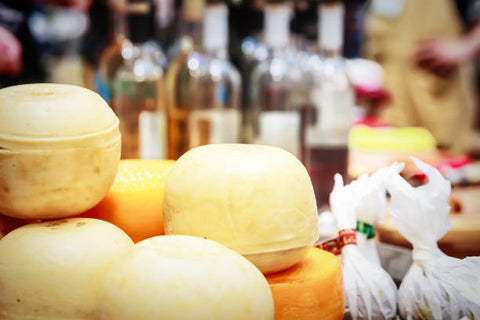Terroir is a fundamental concept in French cuisine, referring to the unique combination of environmental factors that contribute to the distinctive flavors and characteristics of agricultural products. This article explores the role of terroir in French cuisine, highlighting how it shapes the flavors, traditions, and cultural identity of the country's culinary heritage.
-
Soil Composition: The composition of the soil is a crucial element of terroir. Different regions in France have diverse soil types, including limestone, clay, granite, and volcanic soil. These variations in soil composition impart specific mineral profiles to the crops grown in each region, contributing to the unique flavors and qualities of the ingredients used in French cuisine.
-
Climate and Weather: The climate and weather conditions of a particular region greatly influence the flavors and ripening patterns of crops. From the cool maritime climate of Brittany to the warm Mediterranean climate of Provence, each region in France has its own microclimate that impacts the growth and development of agricultural products. The balance of sunlight, rainfall, temperature, and seasonal variations contributes to the distinct flavors and characteristics of the ingredients.
-
Topography and Altitude: The topography and altitude of an area also play a significant role in terroir. Mountainous regions, such as the Alps or the Pyrenees, have different microclimates at varying altitudes. Slopes and valleys affect water drainage and sunlight exposure, influencing the growth and quality of crops. The interaction between topography, altitude, and microclimates creates unique terroirs that shape the flavors and aromas of the ingredients.
-
Plant Varieties and Biodiversity: Terroir is closely linked to the specific plant varieties and biodiversity found in a region. French cuisine celebrates a wide range of local, heirloom, and indigenous varieties of fruits, vegetables, grains, and herbs. These local varieties have adapted to the specific terroir of their respective regions, developing distinct flavors and characteristics that are deeply ingrained in French culinary traditions.
-
Vineyard Terroir and Wine: Terroir is particularly associated with the vineyards of France. The combination of soil, climate, topography, and grape varieties gives each wine-producing region its unique terroir. The concept of terroir in winemaking reflects the belief that the environmental factors in a vineyard directly influence the character, aroma, and taste of the wine produced, making French wines highly sought after worldwide.
-
Culinary Traditions and Recipes: Terroir is not limited to wine; it extends to all aspects of French cuisine. The flavors, techniques, and recipes developed in each region are deeply rooted in the local terroir. Traditional dishes, such as Bouillabaisse from Provence or Cassoulet from Languedoc, are influenced by the ingredients available in the specific terroir of their origin, resulting in unique and regionally specific culinary experiences.
-
Cultural Identity and Sense of Place: Terroir is not just about flavors; it is a reflection of the cultural identity and sense of place. French cuisine is deeply intertwined with the land, and terroir is a way of honoring and celebrating the unique qualities of the local environment. Terroir contributes to the cultural heritage and regional pride, creating a strong connection between people, their food, and the land from which it originates.
-
Sustainability and Responsible Agriculture: Terroir encourages sustainable and responsible agricultural practices. Preserving and nurturing the unique qualities of the land requires a long-term commitment to environmentally friendly farming methods. Sustainable practices, such as organic farming, biodiversity conservation, and land stewardship, help maintain the integrity of the terroir and ensure its sustainability for future generations.
-
Consumer Appreciation and Education: Terroir encourages consumer appreciation and understanding of the flavors and qualities of locally sourced ingredients. By learning about the concept of terroir, consumers can make informed choices, support local producers, and develop a deeper connection with the food they consume. Understanding terroir enhances the overall culinary experience and fosters a greater respect for the environment and cultural heritage.
-
Terroir Beyond France: The concept of terroir has spread beyond France and is now embraced by culinary enthusiasts and producers worldwide. The recognition of terroir emphasizes the importance of local and sustainable food production, celebrating the unique flavors and qualities that arise from a specific place. The influence of terroir can be seen in the growing interest in regional and artisanal products, as consumers seek to experience the authentic flavors and stories associated with specific terroirs.
-
Terroir Labels and Certifications: France has developed various terroir labels and certifications to protect and promote the unique qualities of regional products. These labels, such as Appellation d'Origine Contrôlée (AOC) and Protected Designation of Origin (PDO), guarantee that certain products are produced according to strict criteria tied to specific terroirs. Terroir labels provide consumers with assurance regarding the origin, quality, and authenticity of the products they purchase.
-
Influence on Cheese Production: Terroir plays a significant role in the production of French cheeses. The specific grasses, herbs, and flowers that the cows, sheep, or goats feed on contribute to the distinct flavors and aromas of the milk and, consequently, the cheeses. Different terroirs result in a diverse range of cheeses, each with its unique characteristics and regional identity.
-
Impact on Honey and Beekeeping: Terroir also affects the flavors and qualities of French honey. Bees gather nectar from local flora, and the specific floral sources in a given terroir impart distinctive flavors to the honey. The diverse landscapes and vegetation in different regions of France contribute to a wide variety of honey flavors, showcasing the impact of terroir on beekeeping and honey production.
-
Influence on Spirits and Liqueurs: Terroir influences not only wine production but also the production of spirits and liqueurs in France. For example, certain regions are known for their unique brandies, such as Cognac and Armagnac, which are made from specific grape varieties and aged in oak barrels. The terroir imparts distinct characteristics to these spirits, resulting in flavors that are tied to the land from which they originate.
-
Terroir in Charcuterie and Cured Meats: Terroir influences the flavors and qualities of French charcuterie and cured meats. The type of feed given to the animals, the breed, and the specific climate and environmental conditions all contribute to the unique flavors and textures of the meats. Regions known for their cured meats, such as Bayonne ham or saucisson from the Ardèche region, showcase the influence of terroir on these traditional products.
-
Terroir and Chocolate: Terroir has gained recognition in the world of chocolate, with French chocolatiers emphasizing the importance of sourcing cocoa beans from specific regions. Just like coffee, cocoa beans exhibit distinct flavors and characteristics based on the terroir in which they are grown. The soil, climate, and even the surrounding flora influence the final flavor profiles of chocolates, allowing consumers to explore the unique terroir of different cocoa-producing regions.
-
Terroir in Vegetables and Fruits: Terroir extends beyond traditional agricultural products and also affects the flavors and qualities of vegetables and fruits. Specific terroirs can result in variations in sweetness, acidity, and overall flavor profiles of produce. Celebrated vegetables like the Ratte potato from Brittany or the Pauillac asparagus from Bordeaux exemplify how terroir contributes to the exceptional taste and quality of these ingredients.
-
Terroir and Gastronomic Tourism: Terroir plays a significant role in promoting gastronomic tourism in France. Travelers are drawn to regions known for their distinct terroirs, eager to explore the local cuisine, visit vineyards, indulge in cheese tastings, and experience the flavors associated with specific regions. Terroir-based gastronomic tourism contributes to the economic development of rural areas and supports local producers.
-
Terroir as a Source of Inspiration: Terroir inspires chefs and culinary enthusiasts to create innovative dishes that celebrate and showcase the unique qualities of ingredients from a specific region. By understanding the characteristics imparted by terroir, chefs can experiment with flavor combinations and techniques that enhance and complement these qualities, resulting in dishes that highlight the true essence of the land.
-
Terroir as a Cultural Heritage: Terroir is deeply ingrained in the cultural heritage of France. The celebration of terroir reinforces the connection between the land, its people, and their traditions. It preserves culinary heritage, fosters regional pride, and promotes sustainable agricultural practices that respect the environment. Terroir represents a cultural legacy that is passed down from generation to generation, shaping the culinary identity of the country.
Terroir is a cornerstone of French cuisine, encompassing the unique combination of soil, climate, topography, and biodiversity that contributes to the distinctive flavors and qualities of agricultural products. From wine and cheese to honey, spirits, and cured meats, terroir plays a vital role in shaping the flavors, traditions, and cultural identity of French gastronomy. Terroir labels, culinary tourism, and the creative inspiration it provides to chefs further highlight the significance of terroir in the culinary landscape. Understanding and appreciating terroir enhances the culinary experience, fosters sustainability, and preserves the rich cultural heritage of French cuisine.




